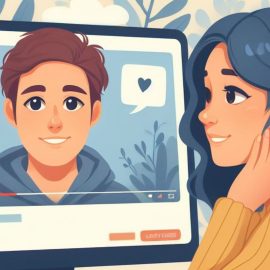

This article is an excerpt from the Shortform book guide to "Come As You Are" by Emily Nagoski. Shortform has the world's best summaries and analyses of books you should be reading.
Like this article? Sign up for a free trial here .
What causes sexual desire? How does context or environment affect our perception of sexual stimuli?
According to sex researcher Emily Nagoski, the best way to think about desire is that it’s the result of context interacting with what we find pleasurable. In other words, depending on the contextual factors at any given time, we may or may not find something pleasurable enough to want more of it.
Keep reading to learn about the causes of desire, the different ways people experience desire, and what causes a lack of desire.
Emily Nagoski on Sexual Desire
What causes sexual desire? According to Emily Nagoski, desire is the result of the interplay between context and what we find pleasurable.
Exactly how pleasurable a person needs to find something before they experience desire depends on the individual. Essentially, everyone has a different desire threshold—some people require more pleasurable sensation than others to cross the threshold into “I want more.”
(Shortform note: Although Nagoski acknowledges that everyone has a different desire threshold, she doesn’t touch on cases where people experience no desire at all. For instance, some people identify as asexual, which means they have little to no sexual attraction to others or desire to have sex. Depending on the person, the absence of desire can extend more broadly: For example, some asexual individuals feel no desire to masturbate or even be involved in romantic relationships involving non-sexual intimacy.)
Although there’s a wide array of variation from person to person, Nagoski says we can generally divide our experience of desire into two types: spontaneous and responsive.
Spontaneous vs. Responsive Desire
Nagoski defines spontaneous desire as when a person wants sex immediately after recognizing a sex-related stimulus, such as getting turned on by the scent of a partner’s perfume. (Another way of thinking about this type of desire is that it’s desire in anticipation of sexual pleasure.) Someone with a low pleasure threshold would experience this type of desire more easily because it generally takes very little stimulation to make them want more. In the aforementioned instance, for example, just the smell of someone creates enough excitement to incite desire.
In contrast, Nagoski defines responsive desire as when a person experiences desire in response to sexual pleasure, such as physical stimulation like kissing or touching. This type of desire is especially common for those who have a higher threshold because they generally require higher amounts of pleasure to become turned on.
Importantly, adds Nagoski, spontaneous desire doesn’t equate to more interest in sex, nor does responsive desire equate to less interest in sex. These descriptions are simply used to describe how different people come to experience desire, and this can change from person to person, context to context, or even over time.
Misconceptions About Desire
While needing more pleasurable sensation to cross the threshold doesn’t inherently mean that a person has a low level of desire (they might just have more responsive desire), Nagoski acknowledges that some people do seem to have less interest in sex than others.
(Shortform note: Although Nagoski’s discussion focuses primarily on women’s lack of interest in sex, there are certain medical reasons for low desire that can affect anyone, regardless of sex. These include chronic illnesses like diabetes and sleep apnea as well as certain medications, such as antidepressants and those that treat high blood pressure.)
Unfortunately, just as with many other aspects of sexuality, our culture spreads a lot of misconceptions about desire and why some (especially women) seem to have a lack of it. Nagoski mentions several in particular that harm women’s sexuality: desire as a drive, hormones and monogamy as causes of lack of desire, and drugs as a treatment option.
Misconception #1: Desire Is a Drive
Despite the prevalence of the term “sex drive” in modern culture, Nagoski says that desire isn’t a drive like hunger or thirst. We know this because to go without it has no impact on our survival. Without food and water, we die—without sex, the most we feel is frustrated.
(Shortform note: While research supports Nagoski’s claim that there are no negative physical health effects of not having sex, there are positive effects of having sex regularly. Some of the proven benefits include improved immune system function, reduced blood pressure, lower stress levels, and reduced risk of cardiovascular problems.)
Nagoski observes that when people are told that desire is a drive, it makes them feel as if having less of it means there’s something fundamentally wrong with them. What’s more, she adds, portraying desire as a drive creates a dangerous sense of entitlement surrounding sex. If sex is a need like food or water, suddenly we can excuse inappropriate sexual behaviors as uncontrollable, and this puts people in very real danger.
(Shortform note: This same line of thinking is what underlies the idea that women are somehow at fault for their assault because of what they were wearing at the time. Asking the question “What was she wearing?” in response to a sexual assault allegation suggests that we can’t blame men for their behavior when women dress in a provocative way—in other words, they’re simply acting on an uncontrollable “drive” triggered by the woman’s attire.)
Nagoski tells us that, in reality, desire is a system motivated by incentive. What this means is that when we encounter an appealing external stimulus (like a kiss), our brain compels us to move towards it. Said more simply, when we find something pleasurable, we want more of it.
(Shortform note: Although Nagoski claims that desire is a system motivated by incentive, in reality, this is just as much of a theory as framing motivation as a drive. Researchers have developed several different theories to try to understand what motivates people, including instinct theory, arousal theory, humanistic theory, and expectancy theory.)
Misconception #2: Hormones Cause Lack of Desire
Nagoski asserts that another common misconception is that hormone levels cause lack of desire. Even medical experts are quick to blame a “low sex drive” or “low libido” on hormonal imbalances due to things like birth control, medications, and aging. Nagoski challenges that while it’s true hormones play a role, they have a negligible effect in comparison to emotional factors like stress. For this reason, targeting hormone levels won’t have a noticeable effect on lack of desire.
(Shortform note: In her argument against targeting hormone levels as a cause of desire, Nagoski doesn’t clearly define which hormones she’s referring to and instead groups them all together. However, she later attributes lack of desire to stress, which is itself linked to a type of hormone—cortisol. Does this mean that hormones can cause lack of desire after all? Or, could it be that Nagoski only means that specific hormones aren’t linked to lack of desire? It’s unclear.)
Misconception #3: Monogamy Decreases Desire
Nagoski notes that yet another misconception is that remaining in long-term, monogamous relationships decreases desire for our partner. One reason for this misconception’s persistence is the fact that many couples begin to have less sex over time.
Nagoski claims that the real culprit of reduced desire in all relationships is context. Because desire is pleasure interacting with context, contextual factors play a much larger role in wanting sex than we realize. She argues that regardless of whether you’re in a monogamous or open relationship, the wrong context will decrease your desire for sex.
(Shortform note: While Nagoski is adamant that context—not monogamy—causes decreased desire, other experts would disagree. For example, the authors of Sex at Dawn use evidence from the social behavior of great apes, remote hunter-gatherer societies, and human biology to argue that monogamy isn’t natural, and therefore it’s expected that we would lose sexual interest in a long-term, monogamous partner.)
Misconception #4: Drugs Can Treat Low Desire
According to Nagoski, many therapists, educators, and medical providers view lack of desire as a medical problem that we should treat with drugs. She says this belief stems from our culture’s favoring of spontaneous desire—the type of desire most often experienced by men. As we’ve already mentioned, our culture uses the average man as the standard for all sexual experiences.
Nagoski argues that the reason drugs can’t treat low levels of desire is that it was never a problem to treat in the first place. She says what is a problem, however, is the stress caused by telling women there’s something wrong with them, which inhibits sexual response and can prevent desire altogether.
(Shortform note: Since the publication of Nagoski’s book, the FDA has approved further medications made to target low desire. For example, scientists developed the drug bremelanotide to treat women who’ve experienced a sudden decrease in desire that they can’t attribute to any other known cause, such as depression, relationship issues, or medication side effects. However, research on the drug’s effectiveness mostly confirms Nagoski’s claim—it was shown to increase sexual desire only modestly, and the benefits were limited to just a portion of women.)
The Causes of Lack of Desire
So if these misconceptions miss the mark regarding the causes of lack of desire, what’s the real reason it happens? Nagoski says that a lack of desire is caused by emotional factors—like stress, depression, and a lack of self-compassion—that are made worse by our sex-negative culture and mismatched desire types in relationships. By this, she means the toxic dynamic that often develops between partners with spontaneous and responsive desire: The partner with responsive desire feels increasingly defensive and guilty in turning down sex, and the partner with spontaneous desire feels increasingly frustrated and rejected in initiating it.
(Shortform note: Lack of desire isn’t the only consequence that arises from the toxic dynamic that can develop between partners of mismatched desire types. The rise in tension that develops as the cycle continues can also negatively impact the couple’s emotional well-being and relationship. One consequence of the cycle, for example, is that it can cause individuals to feel hurt because their partner isn’t addressing their needs. Another outcome is a loss of confidence, especially in the partner who feels consistently rejected. Additionally, the tension can ultimately lead to a lack of trust in the relationship, as the longer the problem persists, the more the couple loses faith in their ability to overcome obstacles together.)
In short, Nagoski concludes, the reality is that there isn’t really a lack of desire—just an abundance of the wrong contextual factors, such as the circumstances, emotional states, and cultural messaging that we discussed earlier on. All of these things activate the SIS and inhibit our desire for sex.

———End of Preview———
Like what you just read? Read the rest of the world's best book summary and analysis of Emily Nagoski's "Come As You Are" at Shortform .
Here's what you'll find in our full Come As You Are summary :
- Why women should change the way they talk, think, and feel about their sexuality
- A look at the misinformation and harmful cultural messaging surrounding sex
- A discussion around the individual experiences of arousal, desire, and orgasm






